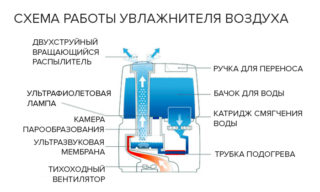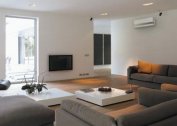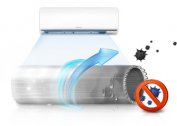Depending on the season and climatic conditions, a household air conditioner cools or heats the air in the room. In standard models there is no humidification function. It is worthwhile to understand the features of the device and ways to normalize the microclimate of the home, as well as find out if the air conditioner dries the air when it is cooled.
Room humidity rate
 Current sanitary rules and regulations provide for an allowable range of humidity in residential premises from 40% to 60%. In the average climatic zone, the natural indicator is in the region of 70%. A refrigeration unit can reduce it to 20-30% in a couple of hours of operation.
Current sanitary rules and regulations provide for an allowable range of humidity in residential premises from 40% to 60%. In the average climatic zone, the natural indicator is in the region of 70%. A refrigeration unit can reduce it to 20-30% in a couple of hours of operation.
For comparison, we can give the Sahara desert as an example. Humidity in this area is 30-50%. It is dry and hot. At high temperature and humidity in the room creates a feeling of stuffiness.
Low humidity of the air masses affects the human condition, affecting:
- the ability of the lungs to absorb oxygen;
- skin elasticity;
- condition of the mucous membranes;
- general health;
- working capacity;
- the development of allergic reactions to synthetic fibers, wool and dust, which were previously associated with water.
With prolonged conservation of low humidity, wooden objects dry out, glue in books loses its basic properties, and paper becomes brittle.
However, increased humidity is more dangerous than dry air. To cause harm to humans, the air must be very dry. To achieve this using a standard domestic air conditioner is quite difficult.
Any split systems dry the air when cooled. Professional devices have a humidification function. However, they are several times more expensive.
The principle of operation of the air conditioner
Explain why the air conditioner dries the air, using the example of a standard appliance. The principle of its action is as follows:
- Split systems have indoor and outdoor units. When the air conditioner is operating in cooling mode in the outdoor unit, freon (refrigerant) is injected into the radiator. It heats up from pressure. Heat from the radiator goes into the atmosphere.
- The cooled freon goes to the internal block. Here it expands sharply, due to which its temperature decreases, and the air in the room gives off heat to the refrigerant.
- Condensation appears on the cold heat exchanger, which is chilled water from the air in the room.
- Then the liquid is discharged to the outside.
To understand how air conditioners moisturize or dry the air, it is worth considering the principle of their operation in different modes.
Air drying during cooling
 A conventional air conditioner is able to dry the air, reducing the humidity level to 15-30% in 1-3 hours. However, such situations only happen with frequent use of the split system.
A conventional air conditioner is able to dry the air, reducing the humidity level to 15-30% in 1-3 hours. However, such situations only happen with frequent use of the split system.
Reducing humidity can have both negative and beneficial effects on human health. The result depends on the climate in the region. In the subtropics, air humidity can greatly exceed the optimal values for humans. For example, in Sochi, it fluctuates around 76-78%. Such humidity far exceeds a comfortable level.
In some cases, you may need an additional dehumidifier, which together with the air conditioner will reduce the concentration of water in the air to the optimal range of 40-60%.
In addition to worsening well-being, increased humidity leads to allergies and the development of mold. The risk of spread of infections in such conditions increases.
The atmosphere in the room becomes stuffy precisely due to high humidity.In cooling mode, the air conditioner is able to increase efficiency and improve the well-being of residents.
Air conditioning
When heating a household air conditioner, it works on the principle of a heat pump, which distinguishes it from any electric heaters. He “pumps” heat from the street to the room even at subzero temperatures.
The operation of the heat pump can be explained by the example of the action of alcohol, which spills on the hand. In such cases, a person feels cold from the rapid evaporation of a liquid. When volatilized, alcohol takes away heat. However, there is a reverse process.
When a liquid condenses, it brings heat with its particles. In nature, this process does not occur explicitly. However, experts were able to reproduce it in an air conditioner:
- Freon condenses under high pressure on the heat exchanger of the indoor unit. As a result, the air conditioning element is heated to 60-80 degrees.
- Then the liquid freon enters the outdoor unit, where it again turns into gas.
- Here it boils, taking heat from the atmosphere.
When the device is in heating mode, the heat exchanger remains warm, so condensate cannot fall out in a large volume, which means that the air conditioner does not dry the air when heated.
Ways to normalize air humidity
 The easiest way to increase humidity is to install an aquarium or a container of water in the room. Water naturally evaporates from the surface, moistening the air masses. The method is effective, but in most cases is insufficient to achieve optimal performance.
The easiest way to increase humidity is to install an aquarium or a container of water in the room. Water naturally evaporates from the surface, moistening the air masses. The method is effective, but in most cases is insufficient to achieve optimal performance.
With intensive use of the air conditioner, it is better to choose such methods:
- Indoor plant indoor installation. To maintain humidity in the range of 40-50%, the leaves should have a large area. However, many plants do not tolerate dry air, so the measure is temporary.
- Installing a room humidifier. The device evaporates water, converting it to a gaseous state by spraying, using heating elements or ultrasound.
- Buying an air conditioner with humidification. Such systems have a nozzle chamber in which a finely dispersed water suspension is sprayed. The device may have a humidity sensor, which allows you to adjust the desired indicator automatically.
- Temporary measure - place wet towels on the battery. The fabric will need to be periodically moistened. Curtains and drapes after washing can not be wrung out completely by hanging them in such a form on the windows.
In winter, air humidity decreases sharply due to the operation of central heating and a large number of electrical appliances. It can reach 10-20%. The microclimate with such indicators is uncomfortable for humans and negatively affects the state of health.
The following preventive measures help prevent a critical decrease in humidity:
- daily air the rooms in the morning and in the evening;
- carry out wet cleaning every 2-3 days;
- insulate the outer walls with foam.
A standard household air conditioner can remove up to 2.5 liters of water from the room per hour. However, its role in draining air is exaggerated. For optimal air exchange in the room, along with a domestic air conditioner, you should purchase a forced ventilation system. As a result, air from the street will flow in sufficient quantities.
Thus, it can be argued that in the cooling mode of the split system, air masses are drained, but not critical to health. To maintain optimal humidity, additional devices are used or resorted to preventive measures.


